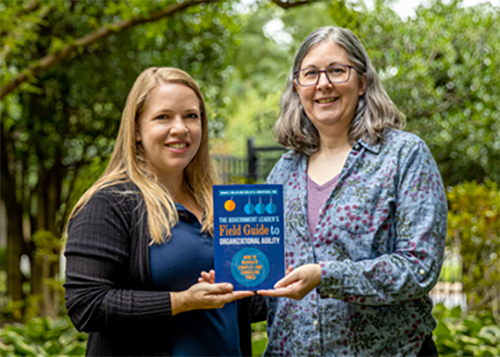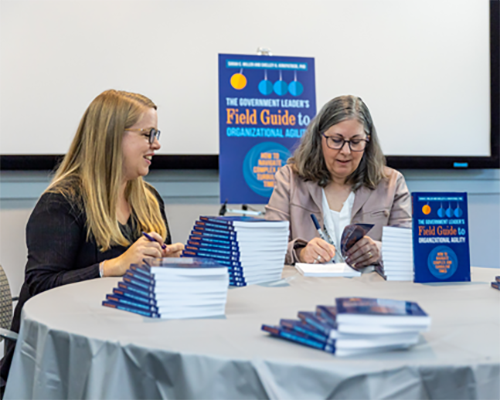New book teaches how to apply agility principles to organizations

Miller and Kirkpatrick, authors of “The Government Leader’s Guide
to Organizational Agility”
Photo Credit: MITRE
Author: Cait Smith
In their new book, The Government Leader’s Guide to Organizational Agility, authors Sarah Miller and Dr. Shelley Kirkpatrick consolidated their combined 42 years of knowledge, tools, anecdotes, tips, and tricks into one resource for government agency leaders at all levels. Leaders are urged to consult the book as a reference when using agility to make organizational changes. So, what is “Organizational Agility” and why do government leaders need to know about it? According to Dr. Kirkpatrick, “Organizational Agility is a whole new approach to carrying out work in a way that makes sense for a constantly changing environment.”
The Organizational Agility approach, pioneered by Miller and Kirkpatrick, consists of seven levers: organizational structure; decision making; knowledge sharing and experimentation; processes; roles; leader actions; and norms & expectations. Miller and Kirkpatrick further developed 20 tools, distributed across those levers, to help frame organizational change. These pieces work in concert to move an organization from a steady state that’s comfortable (yet not always responsive to new realities) to one that nimbly evolves to meet rapidly changing requirements, budgets, policies, resources, and agency strategy. Through their extensive experience, Miller and Kirkpatrick have identified a common theme in many organizations: the sense that requirements are increasing while budgets and manpower are shrinking, making success impossible. Miller says there’s a way out of this conundrum: “The first step a leader should take toward change is to rethink what being a leader looks like in an agile organization instead of a traditional one. Before any changes will occur in the organization the leader needs to foster an environment of psychological safety. If you don’t have that, then none of the rest will work.”
Kirkpatrick elaborates: “You can’t just jump into the other agility behaviors like sensing and responding, sharing knowledge, or working collaboratively unless people feel that it is OK and expected to try new things, even when it doesn’t go perfectly.” In fact, both authors agreed that projects which stall out or fail usually do so because they lack that psychological safety. After establishing psychological safety, the leader should return to the book to reference the remaining levers and associated tools. Each successive element builds on others to truly transform the organization.
Recently, many of Miller and Kirkpatrick’s foundational Organizational Agility principles were put to work as MITRE helped guide a large government agency’s organizational transformation effort. The agency brought together over 3,500 agency senior leaders and staff from across all levels of the organization to collectively define a blueprint and initial roadmap for the agency’s future. According to Becca Lehner, MITRE’s lead for the stakeholder engagement aspect of the effort, “watching the incredible contributions of leaders and staff, particularly in terms of generating psychological safety to support robust discussion across all levels, has been a hallmark of the effort thus far. Tips and tools like those that Sarah and Shelley included in their book support transforming the environment and moving teams and the organization toward an expanded vision of what is possible. There’s a level of awareness, commitment, and passion for partnering to realize this future, and much of it is owed to senior leadership commitment to creating numerous forums for open and engaging dialogue and broad-based collaboration across the agency.”

“The Government Leader’s Guide to Organizational Agility” during the book’s launch party at MITRE in McLean, VA
Photo Credit: MITRE
Helping leaders and government agencies was the primary reason that Miller and Kirkpatrick wrote the book in the first place. After more than four decades of combined experience working with a bevy of government institutions, Miller and Kirkpatrick know a few things about solving complex problems during turbulent times. From their vantage point in MITRE’s Human and Organizational Systems Department they use Organizational Agility tools and principles to design solutions with government agencies and other organizations. Miller and Kirkpatrick decided to publish their knowledge because, as Kirkpatrick states, “our sponsors asked for it. Sarah and I started running the Government Organizational Agility Assessment, or GOAA, with government agency sponsors about five years ago. We realized that they needed help—and asked for our help—to understand what ‘Agility’ is and what it means for their work. We’ve continued to find innovative ways to help them learn while also applying Agility concepts to their organizations. After the GOAA, we developed the MARS Organizational Agility simulation, which helped sponsors practice Agility behaviors. And they asked for even more help—they asked us for the ’handbook‘ that they could use to make their organizations more agile. So, that’s the book we wrote.”
Co-author Sarah Miller puts it best, “Our book is for anyone who needs to make true changes in the way their organization operates. It will take you from catalyst to completion and walk you through every step in between.” The Government Leader’s Guide to Organizational Agility is a seminal work in the field of organizational design. Leaders at all levels of government, academia, consulting, and business can dip into the guide and find workable solutions to help any organizational change.
The Government Leader’s Guide to Organizational Agility can be purchased at most book stores or from Berrett-Koehler online.
For more information about Organizational Agility or The Government Leader’s Guide to Organizational Agility please contact Sarah Miller (scmiller@mitre.org) or Shelley Kirkpatrick (skirkpatick@mitre.org).
Cait Smith is one of the 2021-2022 Army Fellows with MITRE’s Human and Organizational Systems Department. During her 14 years with the U.S. Army, she had three combat deployments and eventually transitioned to the Force Management functional area in 2016, the same year she won the General Douglas MacArthur Leadership Award. Cait received an MBA from The College of William and Mary in 2012, where she is currently taking courses for a Master’s in Business Analytics (Data Science).
© 2022 The MITRE Corporation. All rights reserved. Approved for public release. Distribution unlimited. Case number 22-0120
MITRE’s mission-driven team is dedicated to solving problems for a safer world. Learn more about MITRE.
See also:
A Serious Game Enhances Organizational Agility
Let’s Maintain Agility After the Coronavirus Crisis
A MITRE Innovation Project Headlines in Las Vegas
Untapped Potentional of Serious Games, with Peter Leveille
The ROAR Awards: Two Years and Counting
A Faint Silver Lining Emerges from 2020: A Couple of Lessons Learned About Change
How I Learned to Stop Worrying and Love (Certain) Public-Private Partnerships
Encouraging the Next Generation of Innovative Thinkers
